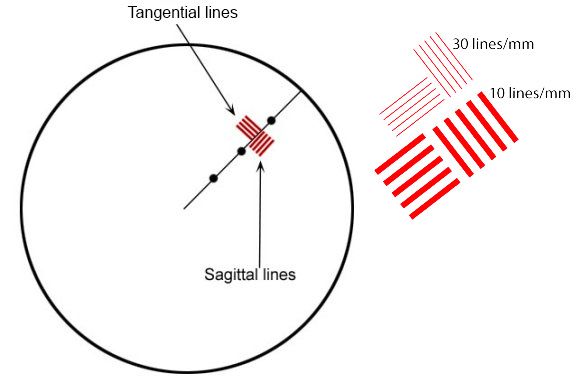Just MTF Charts
Just the MTF Charts: 70-200mm f2.8 Zoom Lenses
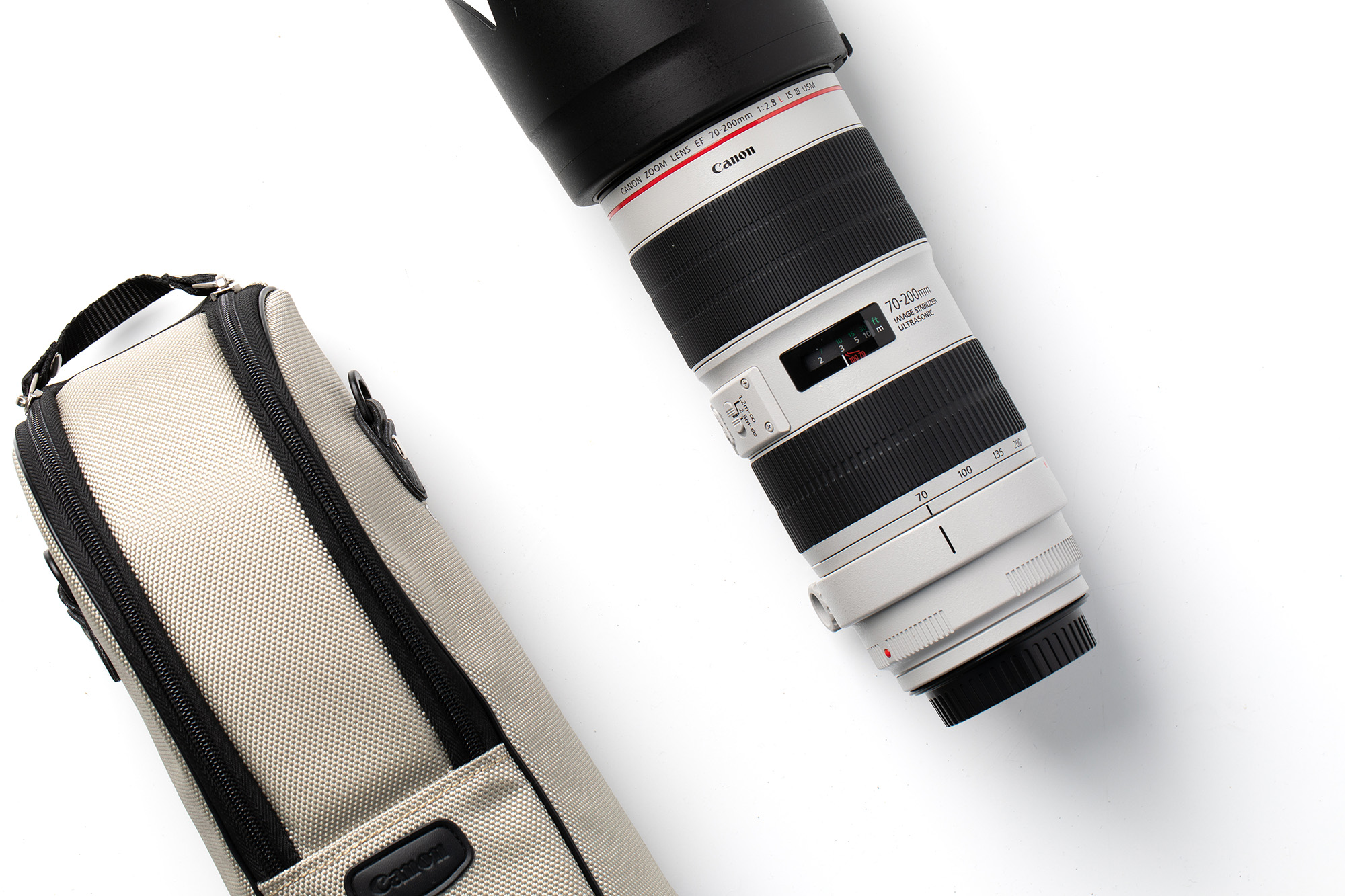
Well, I’ve avoided putting up the zoom lenses as long as I could, but here we are. I’m going to do things a little differently; rather than listing by brand I’m going to try listing by range and type. I’m suspicious of it because it’s going to bring out the Brand Zealots who for some reason find self-worth in owning this brand or that. But it makes sense for a couple of reason. First, zooms require three MTF charts each, and second, some brands have a zillion zooms and some two or three.
Please, let’s try to keep things logical in the comments. If you are triumphant that Brand X lens is better than Brand Y, well, honestly that says a lot more about you than it does about Brands X and Y. And what it says about you makes me sad. You don’t want to make me sad, do you?
Finally, let me put some facts out to start with because some of you may not be familiar with them.
First, most (but not all) of you are aware that zooms are not primes. Every zoom ever made is better at specific focal lengths than at others. I know many of you don’t want it to be so, because you want to know this zoom scores 72.1 and this other one is a 68.4. But MTFs are useful for grown-up photographers who consider their lens a tool. These photographers want to know where their tool works best and worst so they may use its strengths and avoid its weaknesses. You will sometimes find that brand X’s zoom is better at one end, and brand Y’s zoom better at the other. So it goes.
Second, while I’m not going to put out variance graphs (yet), remember that all zooms vary more than primes. All. Every one ever. There are no exceptions. So the average zoom MTF is a broad brush; you can get tendencies from this but not ‘this is how your copy will look pixel peeping information.’ The average data may show that the Wunderbar 70-200mm is sharper at 70mm than at 200mm. Something like 15% to 30% of copies, though, might be sharper at 200mm so if yours is sharper at 200mm, well good for you. Similarly, the Wunderbar may be sharper than the Ultraboy 70-200mm on average. But if you compare one copy of each, 20% to 30% of the Ultraboys could be sharper than the Wunderbar.
That’s how averages and statistics work. So remember when you look at these, we’re showing you trends with a lot of variation. Depending on how you calculate it, between twice to four times the variation that primes have. So please don’t find a small difference and think ‘so this lens is much better’. The reality for that is something like ’57 out of 100 lenses are better’.
For these reasons, on the zoom lenses, I will make some broad comments about things I consider strong tendencies for a given lens that you’ll probably notice. Those are just my opinions, and everybody’s got one, but concerning MTF, mine is the correct one. Notice I don’t give opinions about focusing, or bokeh, or flare, etc. because my opinion isn’t worth doodly on that.
A Quick How to on Reading MTF ChartsIf you’re new here, you’ll see we have a scientific methodology to our approach, and use MTF charts to measure lens resolution and sharpness. All of our MTF charts test ten of the same lenses, and then we average out the results. MTF (or (or Modulation Transfer Function) Charts measure the optical potential of a lens by plotting the contrast and resolution of the lens from the center to the outer corners of the frame. An MTF chart has two axis, the y-axis (vertical) and the x-axis (horizontal). The y-axis (vertical) measures how accurately the lens reproduces the object (sharpness), where 1.0 would be the theoretical “perfect lens.” The x-axis (horizontal) measures the distance from the center of a lens to the edges (measured in millimeters where 0mm represents the center, and 20mm represents the corner point). Generally, a lens has the greatest theoretical sharpness in the center, with the sharpness being reduced in the corners. Tangential & Sagittal LinesThe graph then plots two sets of five different ranges. These sets are broken down into Tangential lines (solid lines on our graphs) and Sagittal (dotted lines on our graphs). Sagittal lines are a pattern where the lines are oriented parallel to a line through the center of the image. Tangential (or Meridonial) lines are tested where the lines are aligned perpendicular to a line through the center of the image. From there, the Sagittal and Tangential tests are done in 5 sets, started at 10 lines per millimeter (lp/mm), all the way up to 50 lines per millimeter (lp/mm). To put this in layman’s terms, the higher lp/mm measure how well the lens resolves fine detail. So, higher MTF is better than lower, and less separation of the sagittal and tangential lines are better than a lot of separation. Please keep in mind this is a simple introduction to MTF charts, for a more scientific explanation, feel free to read this article. |
Canon 70-200mm f/2.8
We’ll start with by far the oldest design of currently produced zooms in this range. It’s a classic lens, considered good by all who have used it, but a decade or more away from being ‘best in class’. We expect the newer designs should be better, although that’s not always the case.
It also kind of sets the trends for all 70-200mm f/2.8 zooms (with a few exceptions): it’s sharper at 70mm than 200mm, gives a very good image in the center 1/2 of the field, but not so great an image in the corners. This isn’t a big deal for most photographers. Since these lenses are so commonly used for sports or portraits; the edges of the image are often not critical (and in fact, the photographer often loves that they are blurry).
At 70mm
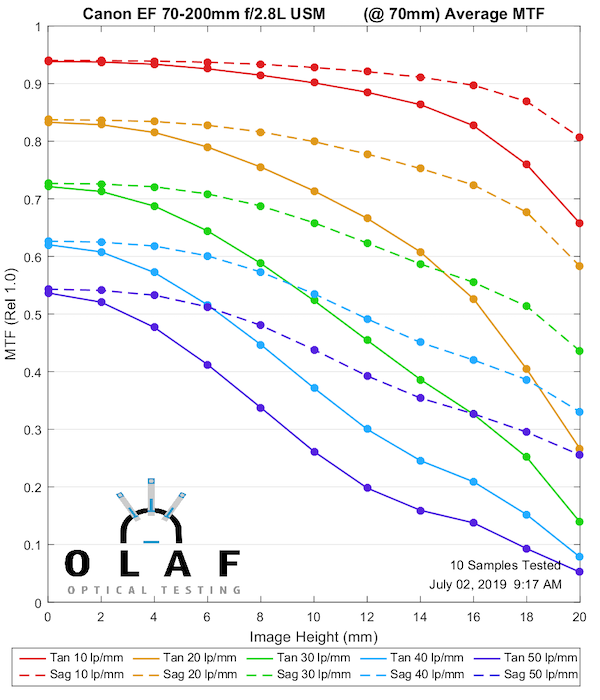
Lensrentals.com, 2019
At 135mm
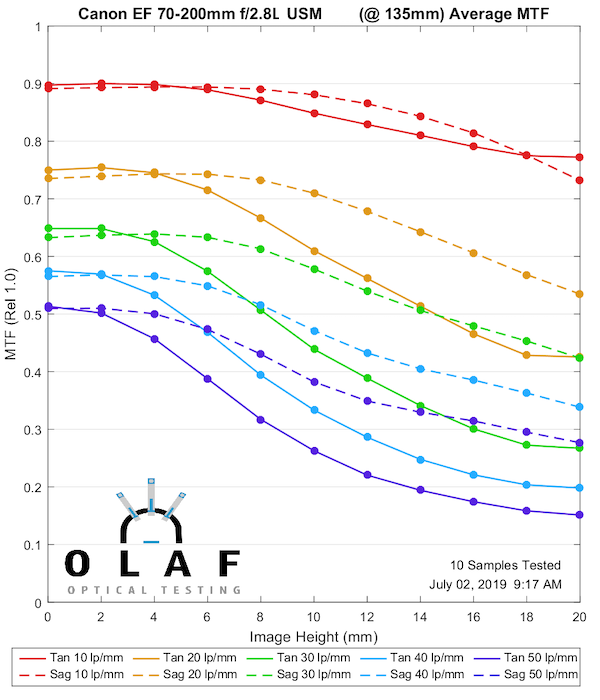
Lensrentals.com, 2019
At 200mm
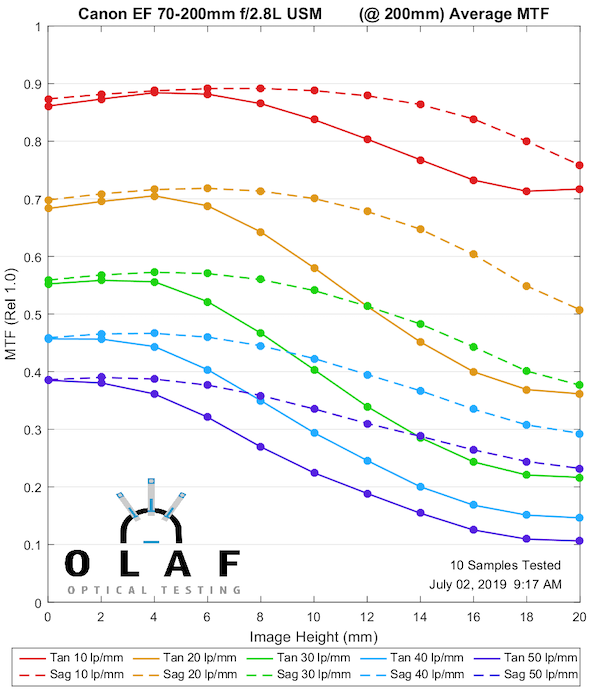
Lensrentals.com, 2019
Canon 70-200mm f2.8 IS II (and III, they’re the same optically)
The IS II version is much better than the NON-IS both in the center and off-axis. It’s still relatively weaker at 200mm, but not as much of a drop-off as the NON-IS. Notice also there is less sagittal-tangential separation now; this indicates improvements of lateral color and/or astigmatism.
One thing to remember, the original version above still makes nice pictures. If you compare them side by side, you’ll notice the difference (better fine detail resolution and off-axis softness isn’t as dramatic), but you would never say the original version’s images suck. I started with these two because a lot of people are familiar with both, and it gives you some perspective to compare the MTF charts with your real-life experience.
At 70mm
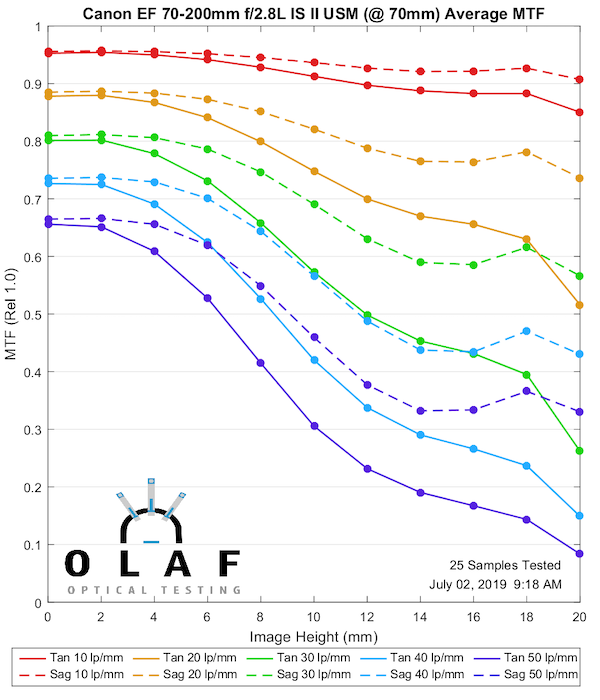
Lensrentals.com, 2016
At 135mm
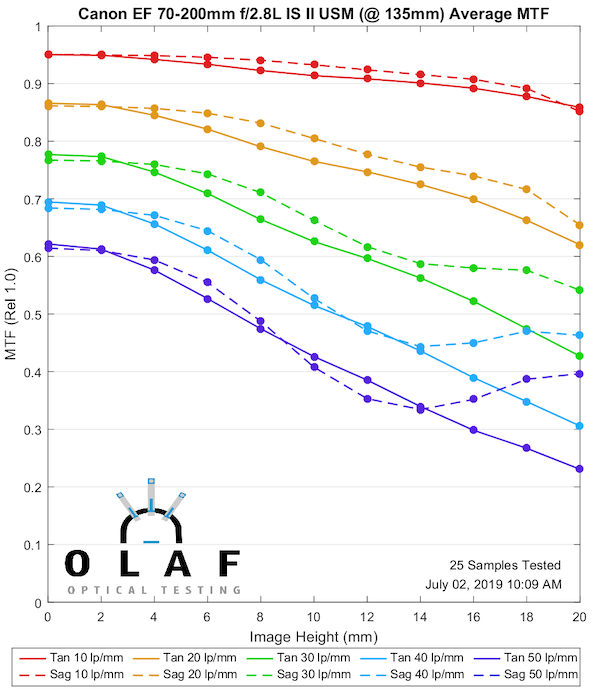
Lensrentals.com, 2016
At 200mm
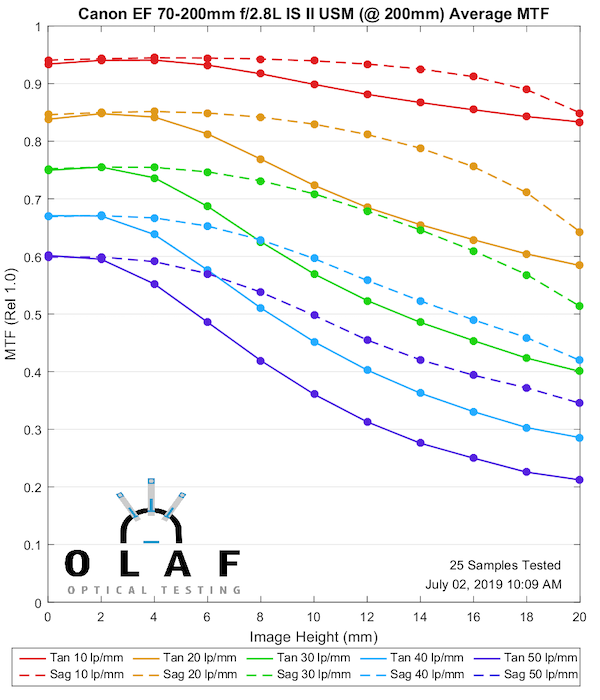
Lensrentals.com, 2016
Nikon 70-200mm f/2.8 VR II
The Nikon VR II is a bit different than most 70-200 zooms; the weakest area (in most copies) is in the middle of the zoom range, but the performance at 200mm is pretty strong.
At 70mm
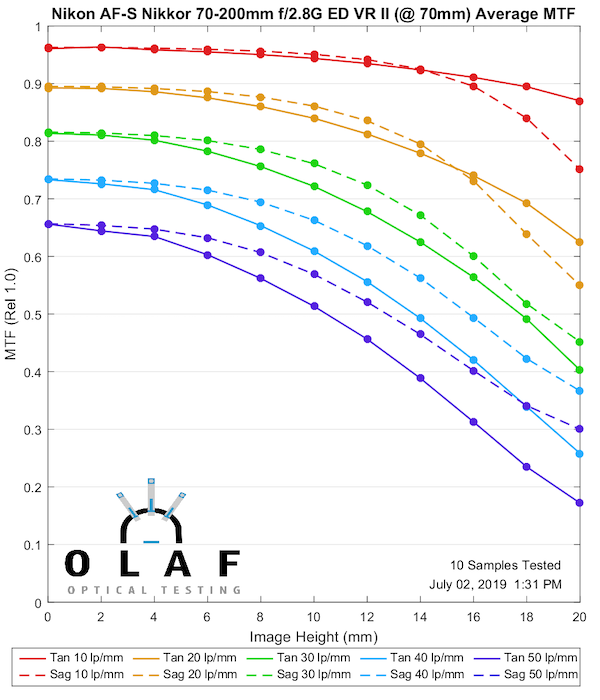
Lensrentals.com, 2019
At 135mm
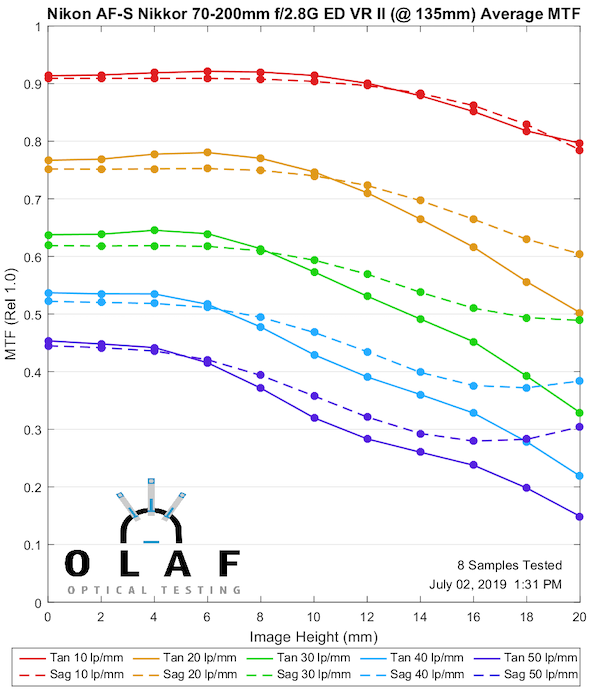
Lensrentals.com, 2019
At 200mm
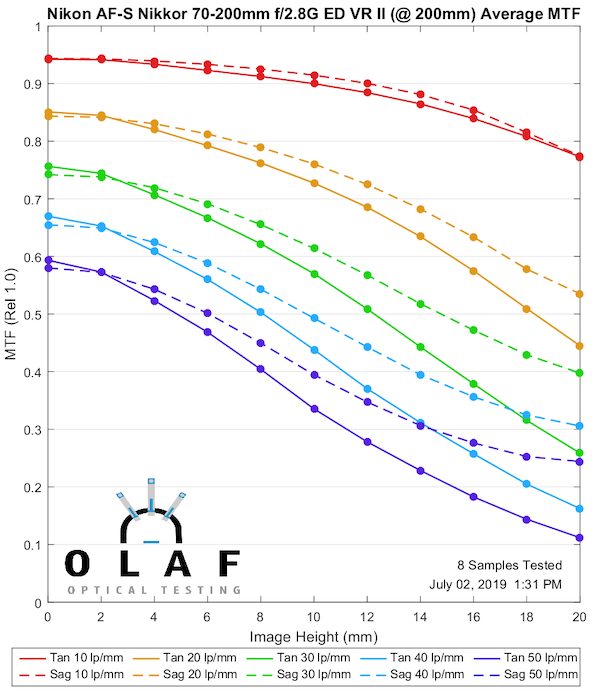
Lensrentals.com, 2019
Nikon 70-200mm f/2.8E FL ED VR
I like to make fun of lenses with half-a-dozen initials in their name, but this Nikon set the standard for all 70-200mm lenses when it was released a few years ago, and is still the best of all of them. So no funs will be made.
At 70mm
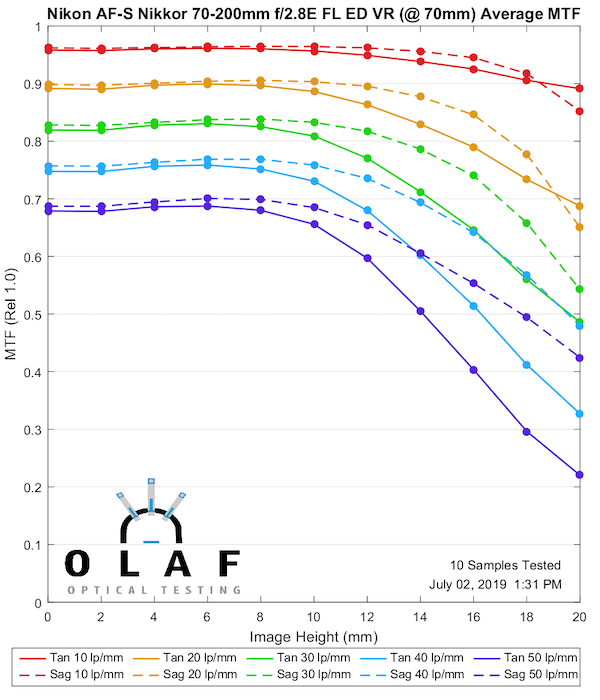
Lensrentals.com, 2019
At 135mm

Lensrentals.com, 2019
At 200mm
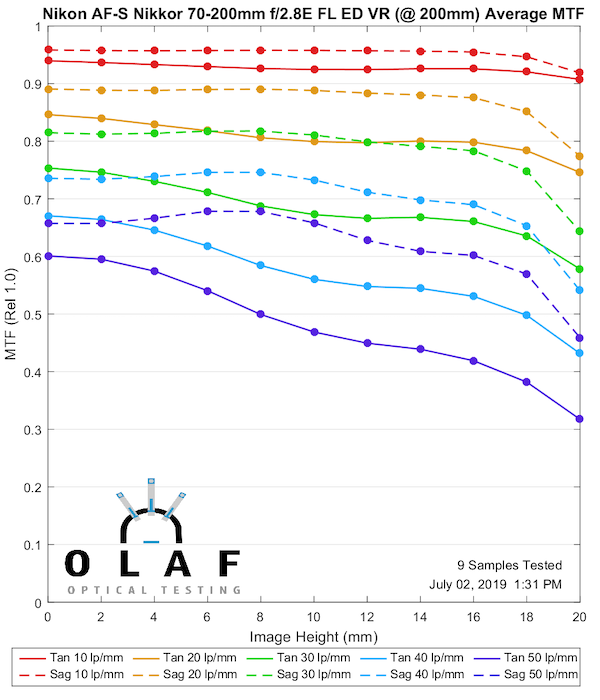
Lensrentals.com, 2019
Sony FE 70-200mm f/2.8 GM OSS
Welcome to the MTF of the most tested lens in our history. Why did we test so many copies? Because Sony fanboys (and employees) were absolutely, positively, certain this lens was the best 70-200mm EVER. It’s not. It’s a decent lens with a LOT of sample variation. A good copy of it is as good as a Canon 70-200mm f/2.8 IS II, which is an excellent lens. A lot of copies aren’t that good, though. Because I see so many stupid things posted about how this lens has been ‘fixed’ and new copies are better, here are a batch of recently tested ones. They are no different than all the other batches we’ve tested.
Full disclosure: I work with Sony. I like Sony. But I despise this lens in case you can’t tell; if you gave me one, I’d sell it the next day. I try to be impartial, but with this lens, I’m not, and I know it. The optical bench, however, is unbiased.
At 70mm
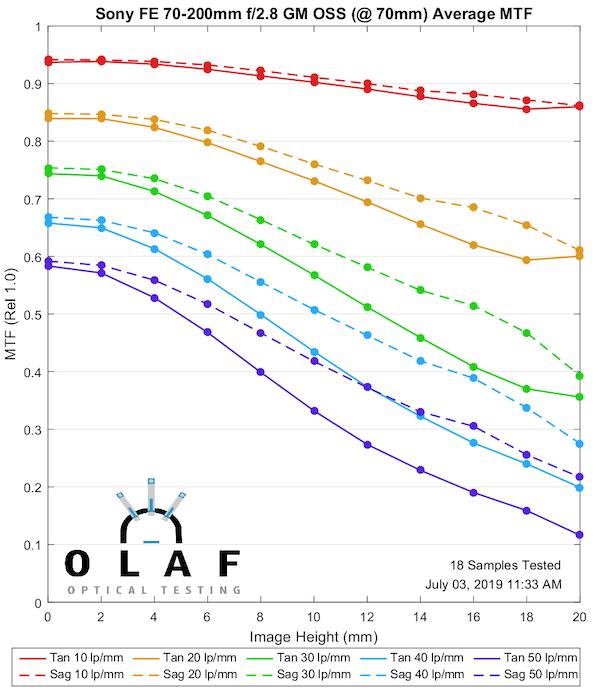
Lensrentals.com, 2016
At 135mm
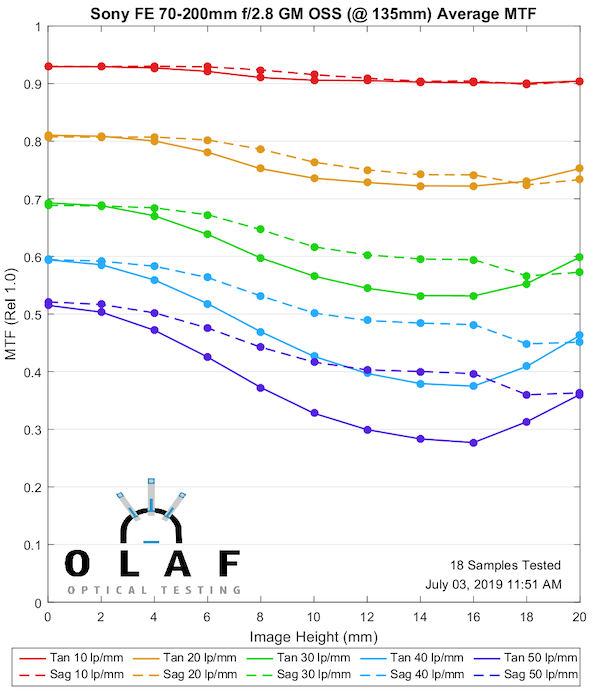
Lensrentals.com, 2019
At 200mm
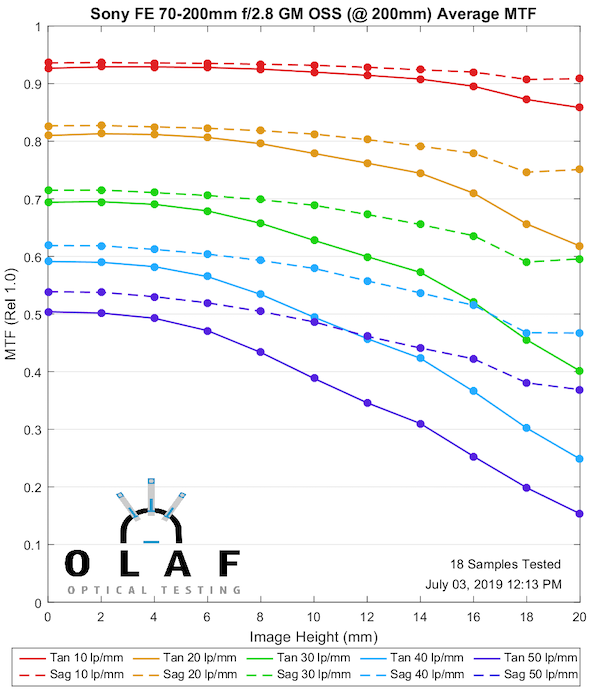
Lensrentals.com, 2019
Tamron SP 70-200mm f/2.8 Di VC USD
Another lens with too damn many initials in its name; and this time it’s not good enough to avoid me mocking it. So I mock you, Divcusd. But while it isn’t too spectacular to mock, optically it’s quite good, very similar to the Canon 70-200mm f/2.8 IS II overall, but with a bit more emphasis on the edges staying strong at the wider end.
At 70mm
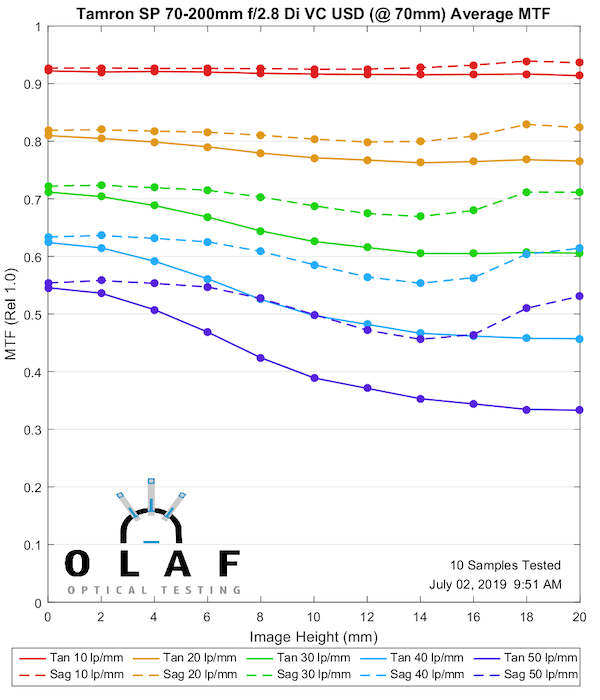
Lensrentals.com, 2019
At 135mm
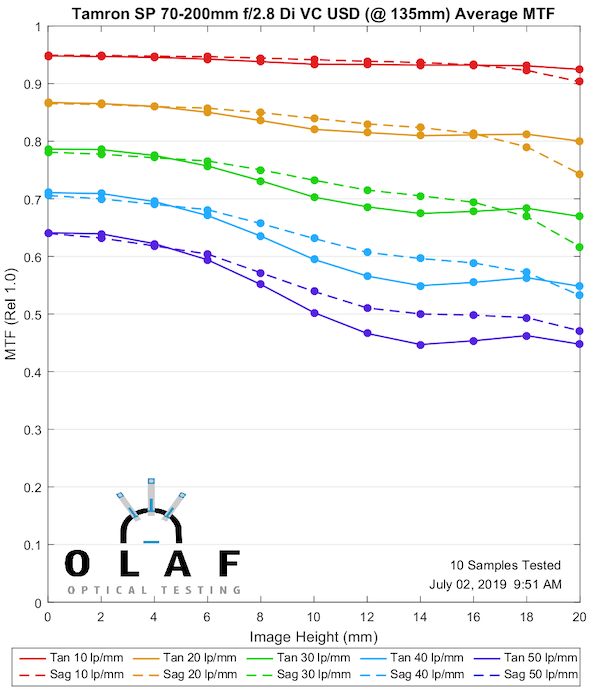
Lensrentals.com, 2019
At 200mm
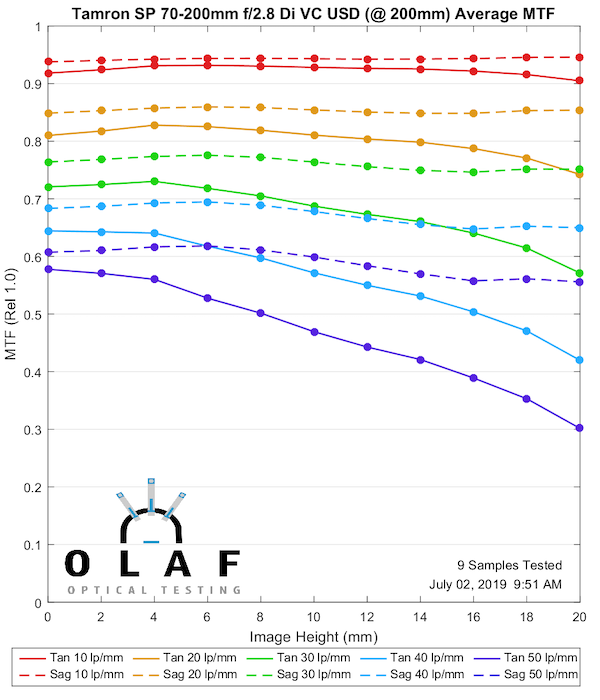
Lensrentals.com, 2019
Sigma 70-200mm f/2.8 Sport
The Sigma has a pattern much like the Nikon VR II; it’s the sharpest of any of these in the center (but not the edges) at 70mm, gets a bit mediocre in the middle of the zoom range, and sharpens up at 200mm.
I’m going to use it as an example of why many people will rave about a 70-200mm lens that I’m critical about. Notice even at 135mm, the lens weakest point, it’s still excellent in the red and orange (lower frequency) curves. It will show reasonably large objects as very sharp and contrasty. It’s only in the higher frequencies (fine detail) that it’s not as good. Fine detail is often not as important as good contrast when using a 70-200mm lens.
At 70mm
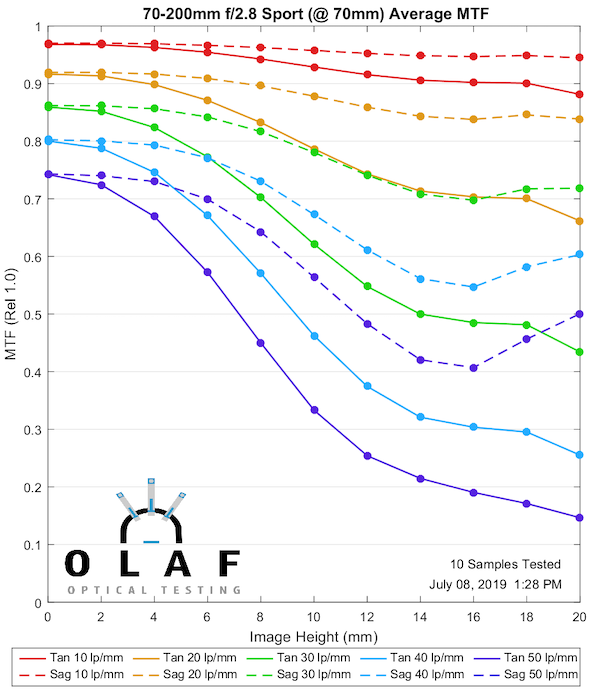
Lensrentals.com, 2019
At 135mm
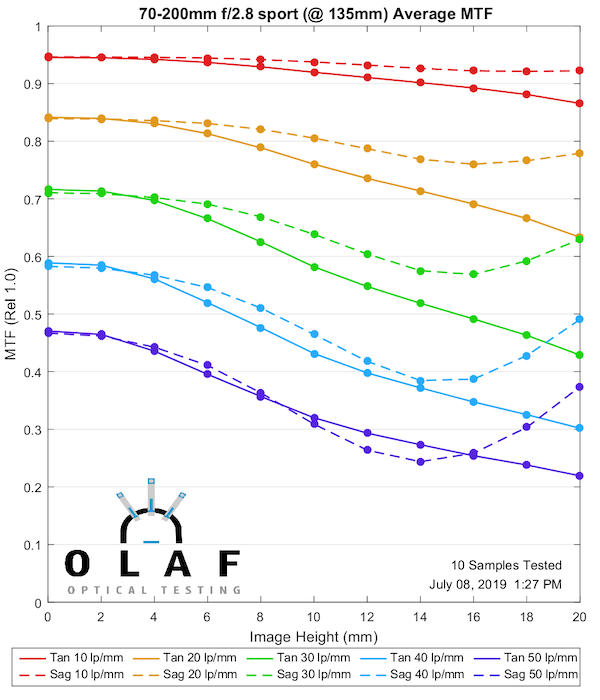
Lensrentals.com, 2019
At 200mm
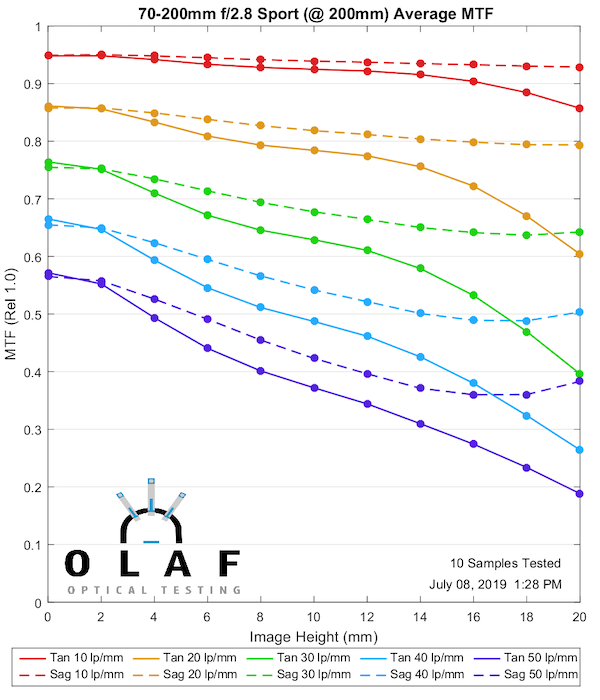
Lensrentals.com, 2019
Just for Fun
I’m going to do Cinema lenses separately, but I thought some of you, at least would be interested to see how these relatively expensive photo lenses compare with a $21,000 Cinema 70-200mm T2.9 zoom.
Zeiss 70-200mm T2.9 Compact Zoom
If you are expecting that extra $18,000 buys you higher resolution, well, nope. What it buys is consistency, lack of focus breathing, a true parfocal image, and accurate focusing scale. In general cinema lenses don’t resolve detail as well as photo lenses; there’s no reason they should and really quite good reasons why they shouldn’t.
70mm
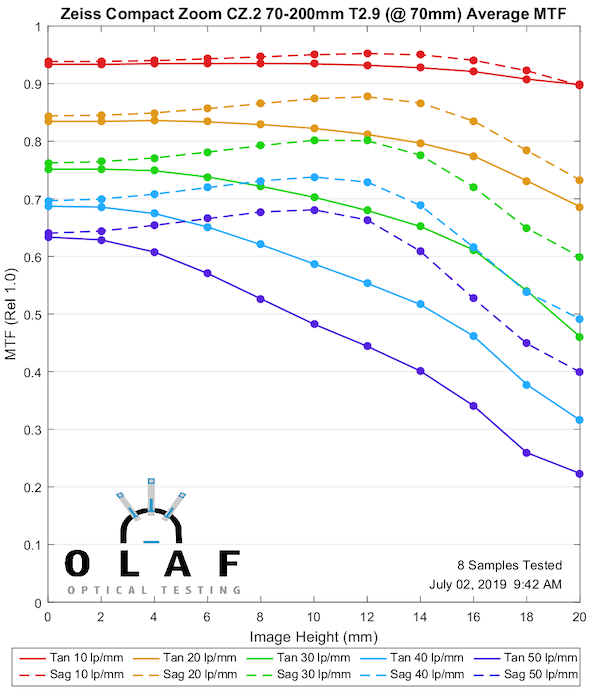
Lensrentals.com, 2019
135mm
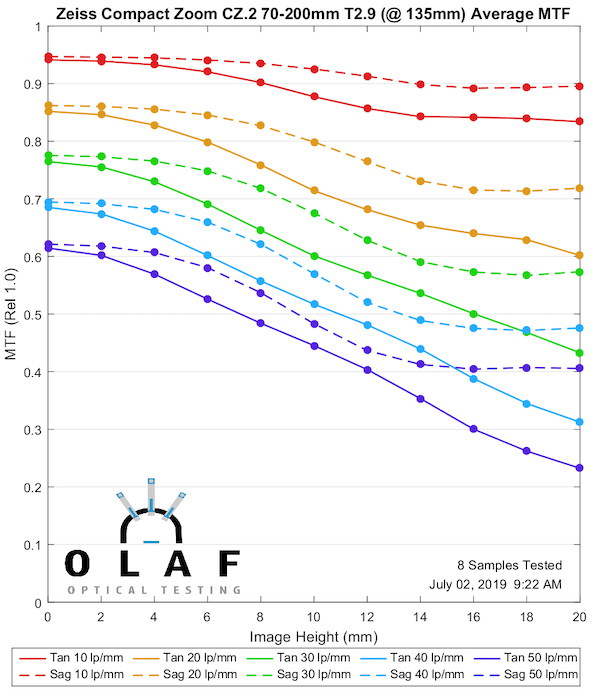
Lensrentals.com, 2019
200mm
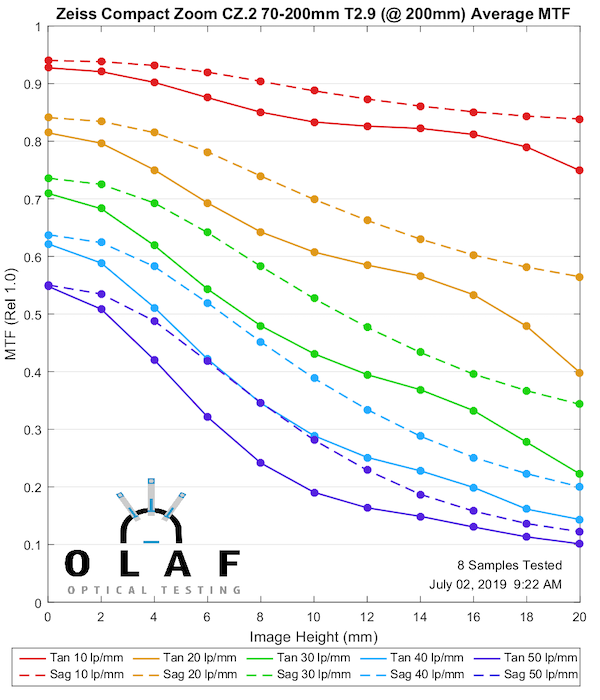
Lensrentals.com, 2019
Summary
The summary is simple. If you shoot Nikon, treat yourself to the FL ED VR if you can afford it. If you shoot anything else, make your choice based on price, how the lens handles and focuses, etc. The MTF curves say they’re all pretty good.
Roger Cicala and Aaron Closz
Lensrentals.com
July, 2019
Author: Roger Cicala
I’m Roger and I am the founder of Lensrentals.com. Hailed as one of the optic nerds here, I enjoy shooting collimated light through 30X microscope objectives in my spare time. When I do take real pictures I like using something different: a Medium format, or Pentax K1, or a Sony RX1R.
-
DrJon
-
Mike
-
DrJon
-
Brandon Dube
-
Brandon Dube
-
Brandon Dube
-
Antonio Sánchez
-
TwoMetreBill
-
Chik Sum
-
SlvrScoobie
-
Anatoly Shapiro
-
Gosh1
-
GulliNL
-
Athanasius Kirchner
-
Athanasius Kirchner
-
Renaud Saada
-
Mike
-
Astro Landscapes
-
Astro Landscapes
-
Astro Landscapes
-
Astro Landscapes
-
Anatoly Shapiro
-
Arlington Brian
-
Mike
-
Baconator
-
JordanViray
-
Andreas Werle
-
Vladimir Gorbunov
-
Michael Jin
-
Carleton Foxx
